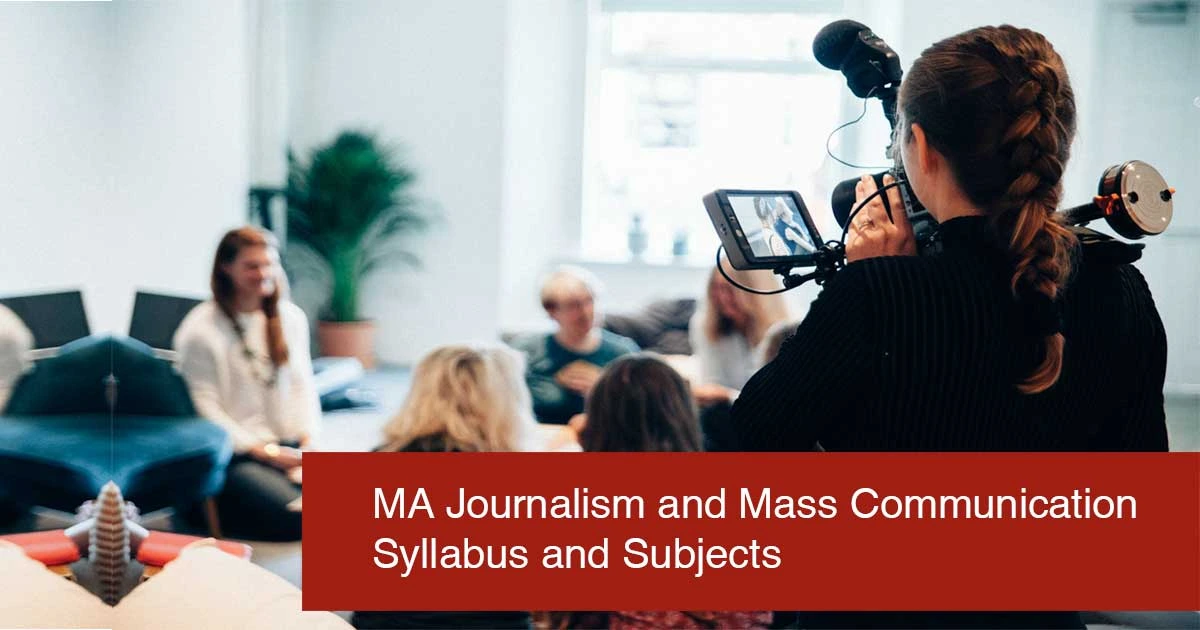Blog Detail


MA Journalism and Mass Communication Syllabus and Subjects
15-05-2025

Table of Content:
- Understanding the programme
- Course structures and semesters
- Semester 1: Foundations of media
- Semester 2: Strengthening core skills
- Semester 3: Specialisation and practical training
- Semester 4: Research and career readiness
- Overview of MA communication syllabus and subjects
- Why pursue a masters in Journalism and Mass Communication in India?
- Skills You’ll Build
- FAQs
In today’s hyper-connected world, the ability to create, curate, and communicate information effectively has never been more vital. With the dynamic media landscape constantly evolving, a master’s degree in Journalism and Mass Communication is a comprehensive programme for those looking to delve deep into media ethics, storytelling, research, and content production. This blog examines the MA Journalism and Mass Communication syllabus and subjects, providing a detailed overview of what students can expect throughout this advanced academic journey.
Understanding the programme
The Masters in Journalism and Mass Communication in India is typically a two-year postgraduate programme designed to equip students with theoretical and practical knowledge. It is ideal for those pursuing careers in print journalism, broadcast media, advertising, public relations and digital content creation. The course enhances one’s writing and reporting abilities and develops a critical understanding of the media’s role in shaping public opinion and culture.
Course structures and semesters
The MA Journalism and Mass Communication syllabus is typically divided across four semesters. Each semester introduces students to new dimensions of communication and media, gradually building their competencies in core and elective areas.
Semester 1: Foundations of media
The first semester provided a strong foundation in communication theories, the history of journalism, and basic reporting and editing techniques. Students are introduced to the principles of mass communication, the media industry structure and ethical considerations in journalism.
Core areas include:
-
Introduction to communication theories
-
History and evolution of mass media
-
Principles of journalism.
-
Basics of news reporting and writing
-
Media laws and ethics
This semester establishes the groundwork for understanding how the media operates and influences society.
Semester 2: Strengthening core skills
As students transition into the second semester, the focus shifts to refining their technical and analytical skills. There is an emphasis on developing visual storytelling skills and understanding communication in a digital context.
Subjects include:
-
Advanced reporting and editing
-
Media research methods
-
Communication and culture
-
Visual communication
-
Development communication
This stage introduces media analysis and promotes a critical examination of the relationship between media, culture and society.
Semester 3: Specialisation and practical training
In the third semester, students explore their specialisation areas and engage in practical learning. Workshops, industry projects, and internships are often integrated during this phase.
Elective and applied areas include:
-
Broadcast journalism
-
Digital journalism
-
Advertising and corporate communication
-
Public relations and event management
-
Media management
This semester is pivotal for shaping professional goals, allowing students to apply classroom knowledge in real-world settings.
Semester 4: Research and career readiness
The final semester is dedicated to consolidating knowledge through research projects or dissertations. Students demonstrate their academic competence by working on a topic that showcases their investigative and analytical skills.
Key elements include:
-
Dissertation/research project
-
Internship/field work
-
Media entrepreneurship
-
Seminar presentations
-
Emerging trends in media
With this, students are prepared to transition seamlessly into professional roles or further academic research.
Overview of MA communication syllabus and subjects
The MA communication syllabus is designed to offer a blend of theoretical frameworks and hands-on training. From media ethics to data journalism, visual storytelling to strategic communication, students are exposed to various areas. The MA Journalism and Mass Communication syllabus also emphasises interdisciplinary learning, drawing from sociology, psychology and political science to build a holistic understanding of the media landscape. Whether print, broadcast or digital media, MA Journalism subjects focus on developing strong communication strategies, editorial judgement and media literacy.
In this curriculum, Journalism and Mass Communication subjects encompass writing and reporting and other aspects of the field. Students also learn about audience analysis, campaign planning, branding and media entrepreneurship, preparing them to adapt to various roles within the communications industry.
Integrating Journalism and Mass Communication subjects across the programme ensures that graduates are well-rounded, technologically adept and ethically grounded professionals. Students often participate in studio sessions, documentary production and news simulations, which simulate real-world experiences.
Why pursue a masters in Journalism and Mass Communication in India?
Choosing to pursue a masters in Journalism and Mass Communication in India offers numerous advantages. With India’s media industry being one of the largest and fastest-growing in the world, students gain exposure to a vast and diverse audience landscape. The country offers a rich context for exploring politics, society, economy, and culture through a journalistic lens.
Moreover, the curriculum is frequently updated to align with global media trends. Students have opportunities to collaborate with international organisations, attend industry seminars, and intern with leading media houses, making them job-ready in a competitive global market.
Skills You’ll Build
A well-structured MA journalism syllabus doesn’t just build subject knowledge; it also develops essential life skills. Through every assignment, project and presentation, students refine their ability to:
-
Communicate effectively across platforms
-
Think critically and analyse information
-
Work collaboratively and lead teams
-
Adapt to technical changes
-
Engage ethically with diverse audiences
Upon graduation, students can take on roles such as news correspondents, editors, content strategists, media researchers, PR executives and media entrepreneurs.
FAQs
Q1. What are 5 good communication skills?
A1.The five essential communication skills that contribute to effective interpersonal and professional interactions include:
-
Active listening
-
Clear and concise speaking
-
Non-verbal communication
-
Emotional intelligence
-
Providing constructive feedback
Q2. What are the 4 types of communication?
A2. The four primary types of communication used in both personal and professional settings are:
-
Verbal communication
-
Non-verbal communication
-
Written communication
-
Visual communication